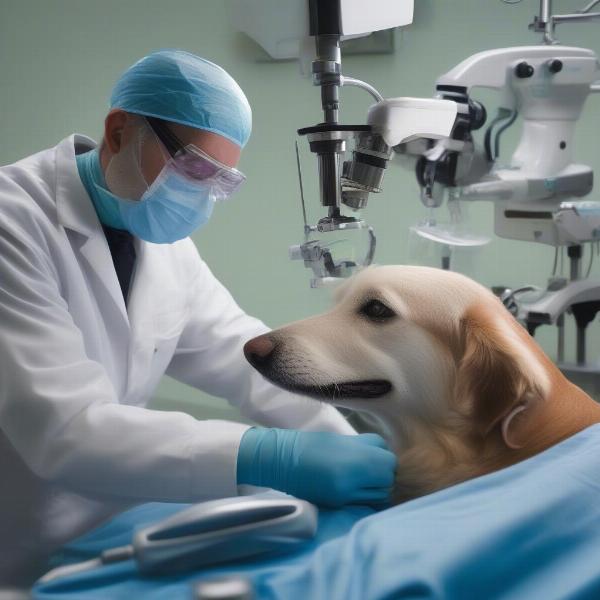Retinal detachment in dogs is a serious condition requiring prompt veterinary attention. While retinal reattachment surgery can offer hope, it’s crucial to understand potential dog retinal reattachment side effects. This article provides essential information on what to expect after this complex procedure, empowering owners to make informed decisions regarding their dog’s eye health.
Retinal detachment occurs when the retina, the light-sensitive tissue at the back of the eye, separates from its supporting layers. This can lead to vision impairment or even blindness. Surgical intervention, aimed at reattaching the retina, is often the best course of action. While the goal is to restore vision, understanding the possible side effects is crucial for managing post-operative care and expectations. These can range from relatively minor discomfort to more serious complications. Knowing what to look for allows for timely intervention and the best possible outcome for your canine companion.
Understanding Dog Retinal Reattachment Surgery and Potential Side Effects
The complexity of dog retinal reattachment surgery means potential side effects are a reality. While not all dogs experience them, being aware of the possibilities allows for proactive monitoring and management. Some common side effects include inflammation, redness, and mild discomfort. More serious, though less frequent, complications can include infection, bleeding, or recurrence of retinal detachment. It’s important to discuss these potential issues with your veterinarian beforehand so you can recognize any warning signs and seek prompt treatment.
 Dog undergoing retinal reattachment surgery
Dog undergoing retinal reattachment surgery
Managing Post-Operative Discomfort and Inflammation in Dogs
After retinal reattachment surgery, your dog will likely experience some discomfort and inflammation. Your veterinarian will prescribe pain medication to manage this. Closely follow their instructions regarding dosage and frequency. Additionally, you may need to use an Elizabethan collar (also known as a “cone”) to prevent your dog from rubbing or scratching their eye, which could disrupt the healing process or introduce infection. Regularly cleaning the area around the eye with a sterile solution, as directed by your veterinarian, will help prevent infection and promote healing.
Recognizing Signs of Infection and Other Complications
While rare, serious complications can arise after retinal reattachment surgery. Being vigilant for signs of infection, such as increased redness, swelling, discharge, or a foul odor, is crucial. Other potential complications include bleeding within the eye or recurrence of the retinal detachment. If you notice any changes in your dog’s eye, such as cloudiness, a change in pupil size, or if your dog seems to be in pain, contact your veterinarian immediately. Early detection and intervention are key to managing these complications effectively.
Long-Term Care and Follow-Up After Retinal Reattachment
Long-term care after retinal reattachment surgery is essential for monitoring your dog’s eye health and ensuring the best possible outcome. Regular check-ups with your veterinarian, including ophthalmic examinations, are necessary to assess the healing process and identify any potential issues. Your veterinarian will provide guidance on activity restrictions and any necessary medications. Following their instructions diligently is crucial for maximizing your dog’s chances of regaining and maintaining vision.
Conclusion
Dog retinal reattachment surgery can be a life-changing procedure, offering the potential to preserve or restore vision. Understanding the potential dog retinal reattachment side effects and committing to proper post-operative care are essential for a successful outcome. By working closely with your veterinarian and following their recommendations, you can provide your dog with the best possible chance of a positive recovery and a brighter future.
FAQ
- How long does it take for a dog’s eye to heal after retinal reattachment surgery? Healing time varies, but typically takes several weeks to months.
- What are the signs of a successful retinal reattachment in dogs? Improved vision and a stable retina during follow-up examinations.
- Can a dog’s vision be fully restored after retinal reattachment surgery? The extent of vision restoration varies depending on the severity of the initial detachment and other factors.
- What are the alternatives to retinal reattachment surgery? In some cases, medical management may be an option, but surgery is often the preferred treatment.
- How can I prevent retinal detachment in my dog? Regular veterinary check-ups are crucial for early detection of eye problems.
- Is retinal detachment painful for dogs? It can be, which is why pain management is a key part of post-operative care.
- What should I do if I notice my dog’s eye looks different after surgery? Contact your veterinarian immediately.
ILM Dog is a leading online resource for dog owners worldwide, offering expert advice on all aspects of dog care, from breed selection and health to training, nutrition, and grooming. We are committed to providing reliable and practical information to help you give your furry friend the best possible life. For more information on dog eye health and other essential topics, visit us at ILM Dog. Contact us at [email protected] or +44 20-3965-8624.